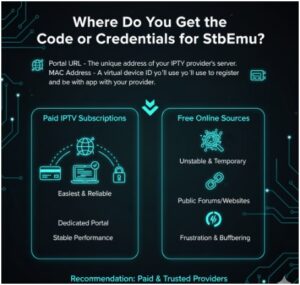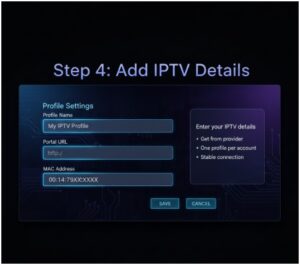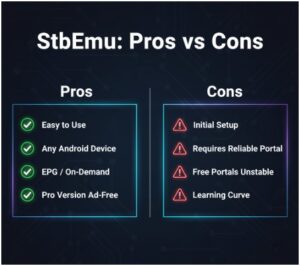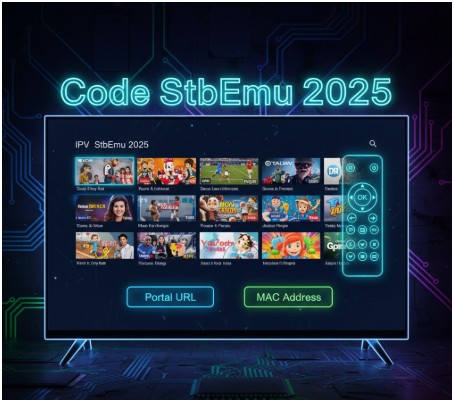I’ll admit something slightly embarrassing: the first time I opened StbEmu on my Android TV, I sat there staring at the screen like it was the cockpit of a spaceship.
I had read all over forums about this magical “code stbemu 2025” that would unlock endless channels, so I expected some secret cheat code. Spoiler: there isn’t one.
Instead, I discovered that StbEmu works like a virtual set-top box. It needs a portal URL and a MAC address from an IPTV provider—not a random code.
Once I understood that, the whole thing suddenly made sense. If you’ve been confused like I was, I’m going to walk you through everything you need to know so you can get StbEmu running smoothly and stop scratching your head.
What Exactly Is StbEmu and How Does It Work?

StbEmu is an app that mimics a traditional IPTV set-top box. Think of it like turning your Android device into a cable box. Instead of plugging in coaxial cables, you plug in digital credentials from your IPTV provider.
When people mention code stbemu 2025, they’re usually talking about finding a working portal link or configuration. But there’s no universal code. Every IPTV provider gives you their own unique portal URL and MAC address. Without these, StbEmu won’t show anything.
This might sound complicated at first, but once you understand the structure, it’s actually quite easy. One account equals one profile, and that profile connects directly to the IPTV service, giving you all their channels, guides, and on-demand content.
Where Do You Get the Code or Credentials for StbEmu?

Here’s where the myth gets busted. There’s no magical “code” for code stbemu 2025 floating around online. What you really need are:
- Portal URL – The unique address of your IPTV provider’s server.
- MAC Address – A virtual device ID you’ll use to register your app with your provider.
You can get these details in two ways:
Paid IPTV Subscriptions:
This is the easiest and most reliable route. When you sign up, your provider sends you a portal URL and tells you what MAC address to use (or lets you pick one).
Free Online Sources:
Some websites and forums share free portal URLs, but they’re usually unstable and go offline quickly. If you just want to experiment, this can be fun—but don’t expect consistent performance.
I personally recommend paying for a trusted provider. It saves so much frustration. My free experiments ended in hours of buffering and dead links.
How Do You Set Up Code StbEmu 2025 on Your Device?

Alright, let’s get into the fun part—the actual setup. This is where I went from confused to feeling like a tech wizard. Follow these steps and you’ll be watching channels in no time.
1. Download the App
Install StbEmu from the Google Play Store or another trusted source.
- The Pro version is ad-free.
- The Free version shows ads but works the same way.
I started with the free version just to test it out.
2. Access the Settings Menu
Once you open the app, you’ll either see a setup screen or a blank screen.
- If the setup screen doesn’t appear, hold the OK button on your remote to open the Menu.
- Go to Settings from there.
This part tripped me up at first—I didn’t realize holding OK opened the hidden settings.
3. Create a New Profile
- Go to Profiles.
- Click New Profile on the right side.
This is where you’ll enter all the magic info from your IPTV provider.
4. Add Your IPTV Details
| Field | What to Enter |
| Profile Name | Any name you like (e.g., “My IPTV”) |
| Portal URL | The link from your IPTV provider |
| MAC Address | Found in STB Configuration → MAC |
After entering the portal, click OK to save. Then copy the MAC address and send it to your IPTV provider so they can activate your account.
5. Restart the App
Completely close the app and reopen it. Now your new profile will load, and you’ll be connected to your IPTV channels.
When my screen finally filled with live TV channels, I honestly did a tiny happy dance in my living room.
What Are the Pros and Cons of Using StbEmu?

Here’s what I’ve learned from using it regularly.
| Pros | Cons |
| Easy to use once set up | Needs manual setup (not plug-and-play) |
| Works on any Android device | Requires reliable portal URL |
| Supports EPG and on-demand TV | Free portals often go offline |
| Pro version is ad-free | Learning curve for beginners |
If you’re okay with a little setup time, the payoff is huge—you get a complete IPTV experience on your TV, phone, or tablet.
FAQs About Code StbEmu 2025
Is there an official code for StbEmu in 2025?
No, there’s no universal or secret code. StbEmu just needs the portal URL and MAC address from your IPTV provider. Once you enter those, your channels appear. It’s more about configuration than unlocking.
Do I need to buy the Pro version to use StbEmu?
Not at all. The free version works just fine and has all the same features, except it shows ads. If the ads bother you or you plan to use it long-term, the Pro version is worth it.
Can I use free IPTV portals with StbEmu?
Yes, but they’re hit-or-miss. Free portals often stop working without warning. If you just want to test the app, they’re fine, but for daily use, go with a paid provider. It’s way more stable and frustration-free.
How do I fix buffering issues on StbEmu?
Buffering usually means your portal is slow or overloaded. Try switching to a better provider, using an Ethernet connection instead of Wi-Fi, or lowering the stream quality. Most of my buffering issues disappeared when I upgraded my internet plan.
Wrapping It Up Like a Pro (Because You Now Are One)
If you’ve been hunting for the elusive code stbemu 2025, now you know the truth: it’s not about finding a magic code—it’s about plugging in the right credentials from your IPTV provider.
Once I stopped searching for shortcuts and just followed the setup steps, StbEmu turned my boring TV box into a full-blown media hub.
If you’re serious about using it daily, invest in a reliable paid IPTV service and save yourself the headaches. And hey, if you ever get stuck, just remember—every “tech wizard” started out as someone confused by a blank screen too.
Now go grab that remote, set up your profile, and enjoy the feeling of being the one who finally cracked the code (even if it wasn’t really a code at all).

